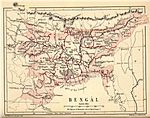
Back বাংলার শাসকগণ Bengali/Bangla Anexo:Gobernantes de Bengala Spanish بنگال دے حکمراناں دی لسٹ PNB بنگال کے حکمرانوں کی فہرست Urdu
This article has multiple issues. Please help improve it or discuss these issues on the talk page. (Learn how and when to remove these messages)
|
| History of Bengal |
|---|
 |
| Part of a series on |
| Bengalis |
|---|
 |
This is a list of rulers of Bengal. For much of its history, Bengal was split up into several independent kingdoms, completely unifying only several times. In ancient times, Bengal consisted of the kingdoms of Pundra, Suhma, Vanga, Samatata and Harikela.
In the 4th century BCE, during the reign of the Nanda Empire, the powerful rulers of Gangaridai sent their forces with the war elephants which led the withdrawal of Alexander the Great from the Indian subcontinent.[1]
With the rise of Gopala in 750 AD, Bengal was united once more under the Buddhist and Shaivite Pala Empire. The Pala period is considered as one of golden eras of Bengali history as it brought stability and prosperity to Bengal after centuries of Civil War, created outstanding works of art and architecture, proto-Bengali language develop under them including its first literary work, the Charyapada and so on. Until the 12th century than being succeeded by the Buddhist and Hindu Chandra dynasty, Sena dynasty and Deva dynasty. The rule of deva dynasty was a period of peace, prosperity and creative excellence and may be designed as "golden age" After them, Bengal was ruled by the Hindu Maharajas of kingdoms such as Chandradwip and Cooch Behar.[citation needed]
In the early 13th century, Muhammad bin Bakhtiyar Khalji conquered Western and part of Northern Bengal,[2] and established the first Muslim kingdom in Bengal.[3] The Islamic Mamluk Sultanate, the Khalji dynasty, the Turko-Indian Tughlaq dynasty, the Sayyid dynasty and the Lodi dynasty ruled Bengal for over 320 years.[4] Notable was Malik Altunia's reign with his wife Razia Sultana, the only female sovereign ruler.[citation needed]
Following Delhi Sultanate's reign, the Bengal Sultanate, a major trading nation in the world,[5] was founded by Shamsuddin Ilyas Shah, and ruled by the Ilyas Shahi dynasty, succeeded by the Hussain Shahi dynasty founded by Alauddin Husain Shah, which saw the extension of the sultanate to the port of Chittagong, witnessing the arrival of the earliest Portuguese merchants.[citation needed]
- ^ "Gangaridai". Banglapedia. Archived from the original on 28 February 2022. Retrieved 28 February 2022.
- ^ Majumdar, R. C. (1973). History of Mediaeval Bengal. Calcutta: G. Bharadwaj & Co. pp. 1–2. OCLC 1031074.
Tradition gives him credit for the conquest of Bengal but as a matter of fact he could not subjugate the greater part of Bengal ... All that Bakhtyār can justly take credit for is that by his conquest of Western and a part of Northern Bengal he laid the foundation of the Muslim State in Bengal. The historians of the 13th century never attributed the conquest of the whole of Bengal to Bakhtyār.
- ^ Arnold, Thomas Walker (1913) [First published 1896]. The Preaching of Islam: A History of the Propagation of the Muslim Faith (2nd ed.). London: Constable & Company. p. 227.
- ^ Sen, Sailendra (2013). A Textbook of Medieval Indian History. Primus Books. pp. 68–102. ISBN 978-9-38060-734-4.
- ^ Nanda, J. N (2005). Bengal: the unique state. Concept Publishing Company. p. 10. 2005. ISBN 978-81-8069-149-2.
Bengal [...] was rich in the production and export of grain, salt, fruit, liquors and wines, precious metals, and ornaments besides the output of its handlooms in silk and cotton. Europe referred to Bengal as the richest country to trade with.